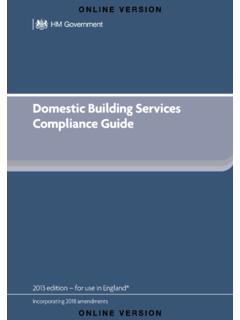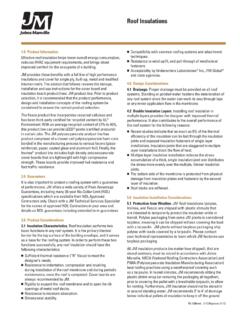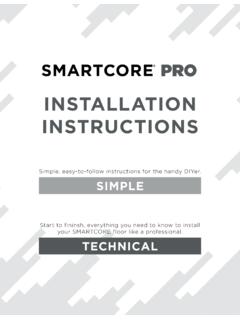Transcription of Non-Domestic Building Services Compliance Guide
1 2013 edition for use in England* Non-Domestic Building Services Compliance GuideCompliance Guide Non-Domestic Building Services ONLINE VERSIONONLINE VERSION* Note: Any reference to the Building Regulations in this Guide is to the Building Regulations 2010 in England (as amended). These Regulations also apply to the following Building work in Wales:(a) work on an excepted energy Building as defined in the Schedule to the Welsh Ministers (Transfer of functions) (No 2) Order 2009 (SI 2009/3019); and(b) work that is subject to provisions of the regulations relating to energy efficiency specified in regulation 34 of the Regulations and is carried out to educational buildings, buildings of statutory undertakers and Crown buildings, or carried out by Crown guidance comes into effect on 6 April 2014.
2 Work started before this date remains subject to the earlier edition of the guidance. Work subject to a Building notice, full plans application or initial notice submitted before this date will also remain subject to the earlier edition of the guidance, provided it is started before 6 April other jurisdictions in the UK, it will be necessary to consult their own Building regulations and VERSIONONLINE VERSION 1 ContentsContentsSection 1: Introduction Scope Innovative systems European directives Status of Guide How to use this Guide Key terms for space heating and domestic hot water systems Summary of recommended minimum energy efficiency standards 9 Section 2: Gas, oil and biomass-fired boilers Introduction Scope of guidance Key terms Determining boiler seasonal efficiency Boilers in new buildings Boilers in existing buildings Heating efficiency credits for replacement boilers Biomass boilers 24 Section 3: Heat pumps Introduction Scope of guidance Key terms Heat pumps in new and existing buildings Heating efficiency credits for heat pump systems in existing buildings Supplementary information 30 Section 4: Gas and oil-fired warm air heaters Introduction Scope of guidance Key terms Warm air heaters in new and existing buildings Heating efficiency credits for warm air heaters in new and existing buildings 32* Note.
3 Any reference to the Building Regulations in this Guide is to the Building Regulations 2010 in England (as amended). These Regulations also apply to the following Building work in Wales:(a) work on an excepted energy Building as defined in the Schedule to the Welsh Ministers (Transfer of functions) (No 2) Order 2009 (SI 2009/3019); and(b) work that is subject to provisions of the regulations relating to energy efficiency specified in regulation 34 of the Regulations and is carried out to educational buildings, buildings of statutory undertakers and Crown buildings, or carried out by Crown guidance comes into effect on 6 April 2014. Work started before this date remains subject to the earlier edition of the guidance. Work subject to a Building notice, full plans application or initial notice submitted before this date will also remain subject to the earlier edition of the guidance, provided it is started before 6 April other jurisdictions in the UK, it will be necessary to consult their own Building regulations and VERSIONONLINE VERSION2 1 Con1tes2345Sc3 :ea5ymE75f:3231 CSection 5: Gas and oil-fired radiant heaters Introduction Scope of guidance Key terms Radiant heaters Heating efficiency credits for radiant heaters in existing buildings 35 Section 6: Combined heat and power and community heating Introduction Scope of guidance Key terms CHP in new and existing buildings Supplementary information 39 Section 7.
4 Direct electric space heating Introduction Scope of guidance Electric space heating in new and existing buildings 40 Section 8: domestic hot water Introduction Scope of guidance Key terms domestic hot water systems in new and existing buildings Supplementary information on electric water heaters Heating efficiency credits for domestic hot water systems in new and existing buildings 49 Section 9: Comfort cooling Introduction Scope of guidance Key terms Comfort cooling in new and existing buildings Calculating the seasonal energy efficiency ratio for SBEM Supplementary information 55 ONLINE VERSIONONLINE VERSION 3 ContentsSection 10: Air distribution Introduction Scope of guidance Key terms Air distribution systems in new and existing buildings Heat recovery in air distribution systems in new and existing buildings Calculating the specific fan power for SBEM 61 Section 1 1: Pipework and ductwork insulation Introduction Scope of guidance Insulation of pipes and ducts in new and existing buildings 62 Section 12: Lighting Introduction Scope of guidance Key terms Lighting in new and existing buildings Lighting Energy Numeric Indicator (LENI) 68 Section 13: Heating and cooling system circulators and water pumps Introduction Scope of guidance Key terms Glandless circulators and water pumps in new and existing buildings Supplementary information 71 Appendix A.
5 Abbreviations 72 ONLINE VERSIONONLINE VERSION4 1 Con1tes2345Sc3 :ea5ymE75f:3231 CONLINE VERSIONONLINE VERSION 5 Section 1: IntroductionSection 1: ScopeThis Guide provides detailed guidance for the installation of fixed Building Services in new and existing Non-Domestic buildings to help Compliance with the energy efficiency requirements of the Building edition covers the design, installation and commissioning of: conventional means of providing primary space heating, domestic hot water, mechanical ventilation, comfort cooling and interior lighting low carbon generation of heat by heat pumps and combined heat and power systems. The Guide sets out recommended minimum energy efficiency standards for components of Building Services systems, including the use of controls.
6 For systems installed in new buildings, the standards are design limits (or backstop values). For new or replacement systems and components installed in existing buildings, the standards represent reasonable provision for complying with the Building is important to note that standards higher than many of these recommended minimum standards will need to be achieved if: new buildings are to meet the the Building Regulations target carbon dioxide emission rate (TER) calculated using National Calculation Methodology (NCM) tools such as SBEM1 systems (up to 45 kW heat output) are to comply with the Microgeneration Certification Scheme standards that enable Building owners to receive payments under the Renewable Heat Incentive (RHI) and qualify for Green Deal funding products are to be recognised as renewable technologies under the Renewable Energy Guide includes some supplementary information that identifies good practice design and installation standards that exceed the minimum standards in this Guide .
7 Microgeneration Certification Scheme standards2 are an example of good practice standards. In relevant sections, the Guide identifies additional non-prescriptive measures (for example additional controls) that can improve plant efficiency. These may be used to gain heating efficiency credits to help meet the carbon dioxide emission targets for new buildings, or the recommended minimum energy efficiency standards set out in this Guide for work in existing summary of recommended minimum energy efficiency standards is presented in Table 1 at the end of this The National Calculation Methodology (NCM) modelling Guide and the Simplified Building Energy Model (SBEM) tool can be downloaded from VERSIONONLINE VERSION6 1 Con1tes2345Sc3 :ea5ymE75 Innovative systemsIt is also important to note that this Guide covers a range of frequently occurring situations.
8 It deals with the most commonly used fixed Building Services technologies. In doing so it neither endorses these methods and technologies nor excludes other more innovative technologies that may offer an alternative means of meeting the functional requirements of the Building the alternative technology has been the subject of a recognised testing procedure that assesses its energy performance, this may be used to indicate that the system is adequately efficient. In the event that there is no recognised testing standard, suitable calculations or modelling methods may be used to show the carbon performance of the system. European directivesThe design and installation of fixed Building Services products, such as boilers, circulators and heat pumps, shall at the appropriate time comply with all relevant requirements of EU directives as implemented in the United Kingdom.
9 There are a number of directives with requirements that directly or indirectly control the energy efficiency of Building Ecodesign Directive 2009/125/EC provides a framework for establishing requirements for energy-related products placed on the EU market. Current requirements cover energy-using products such as boilers, light bulbs and washing machines. In the future, requirements will also cover products such as windows, insulation material and shower heads whose use has an impact on energy requirements are set out in Commission Regulations listed in the document Products covered by the regulations can only be CE marked and placed on the market if they meet the ecodesign standards the time of preparation of this Guide , Commission Regulations existed or were being developed for.
10 Space heaters and combination heaters water heaters and hot water storage tanks glandless standalone circulators and glandless circulators integrated in products water pumps air conditioners and comfort fans fans driven by motors with an electric input power between 125 W and 500 kW lighting products in the domestic and tertiary sectors electric intention is that the recommended minimum product standards in this Guide should at least match the energy efficiency standards set out in Commission Regulations as they come into force. For example, although the implementing regulations for hot water storage tanks were published in September 2013, the standards do not come into force until September 2017. If in any doubt as to whether a product is subject to minimum ecodesign standards, check the Commission document Energy Labelling Directive 2010/30/EU complements the Ecodesign Directive by providing a framework for labelling of energy-related products including lamps, luminaires, household air conditioners and washing machines.
















